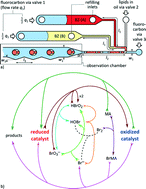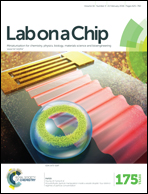Microfluidic platform for reproducible self-assembly of chemically communicating droplet networks with predesigned number and type of the communicating compartments†
Abstract
We report a microfluidic system for individually tailored generation and incubation of core–shell liquid structures with multiple cores that chemically communicate with each other via lipid membranes. We encapsulate an oscillating reaction–diffusion Belousov–Zhabotinsky (BZ) medium inside the aqueous droplets and study the propagation of chemical wave-fronts through the membranes. We further encapsulate the sets of interconnected BZ-droplets inside oil–lipid shells in order to i) chemically isolate the structures and ii) confine them via tunable capillary forces which leads to self-assembly of predesigned topologies. We observe that doublets (pairs) of droplets encapsulated in the shell exhibit oscillation patterns that evolve in time. We collect statistical data from tens of doublets all created under precisely controlled, almost identical conditions from which we conclude that the different types of transitions between the patterns depend on the relative volumes of the droplets within a chemically coupled pair. With this we show that the volume of the compartment is an important control parameter in designing chemical networks, a feature previously appreciated only by theory. Our system not only allows for new insights into the dynamics of geometrically complex and interacting chemical systems but is also suitable for generating autonomous chemically interconnected microstructures with possible future use, e.g., as smart biosensors or drug-release capsules.


 Please wait while we load your content...
Please wait while we load your content...